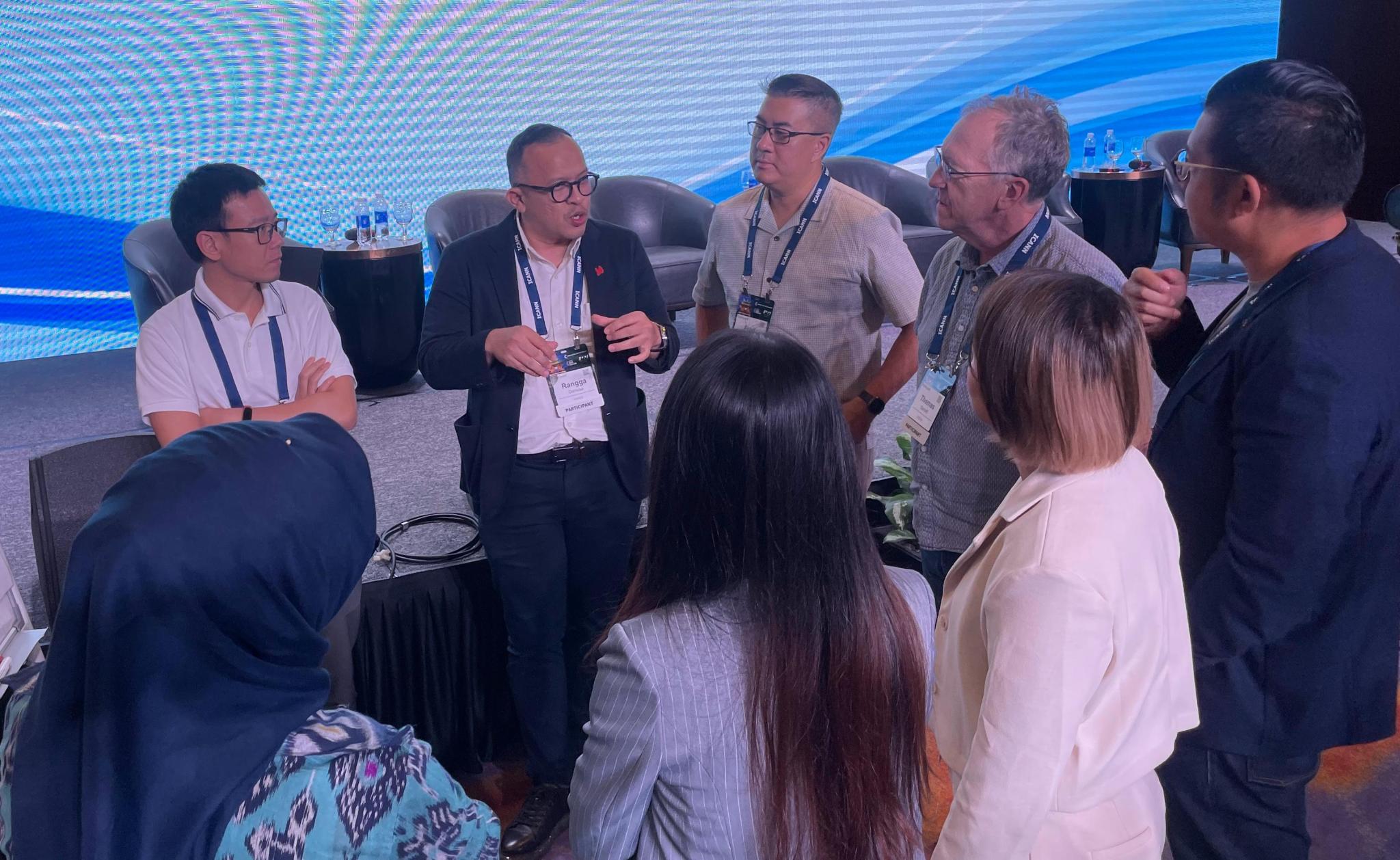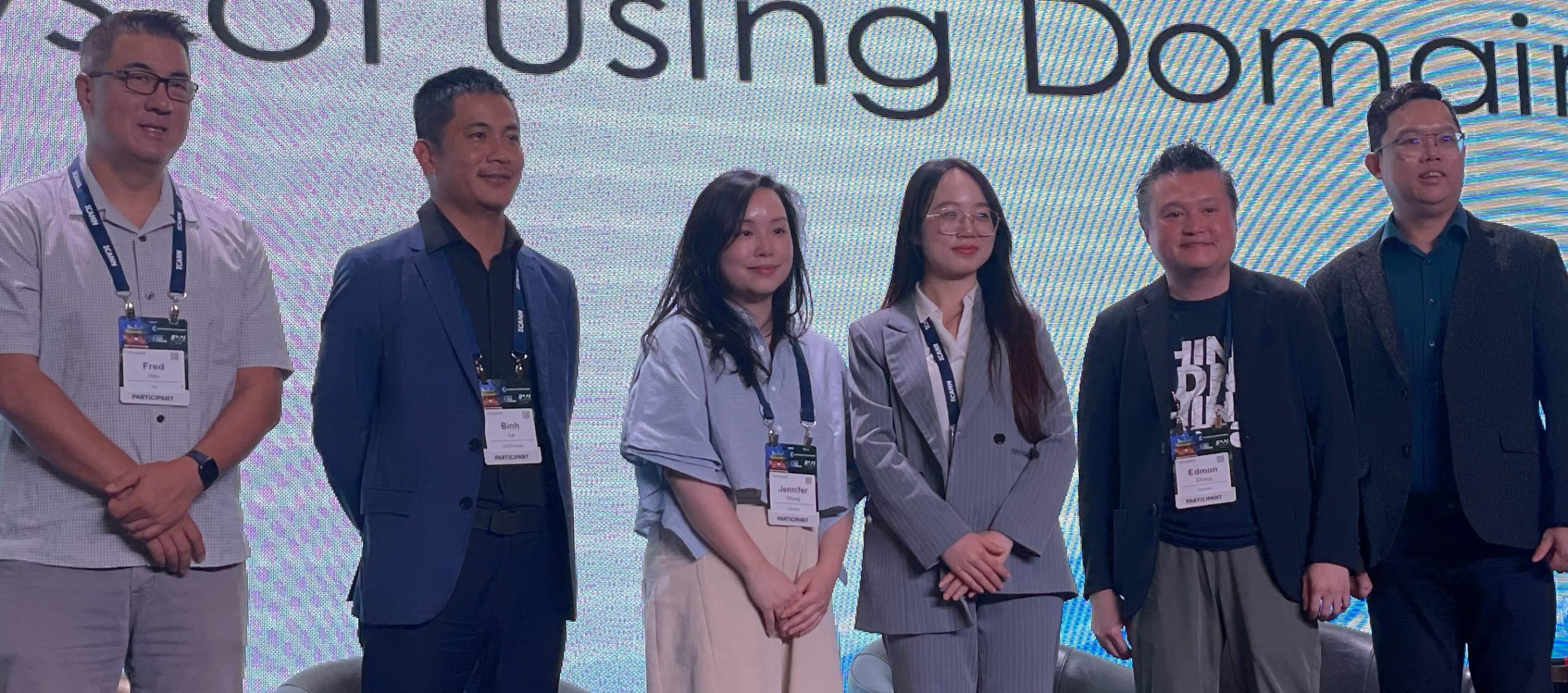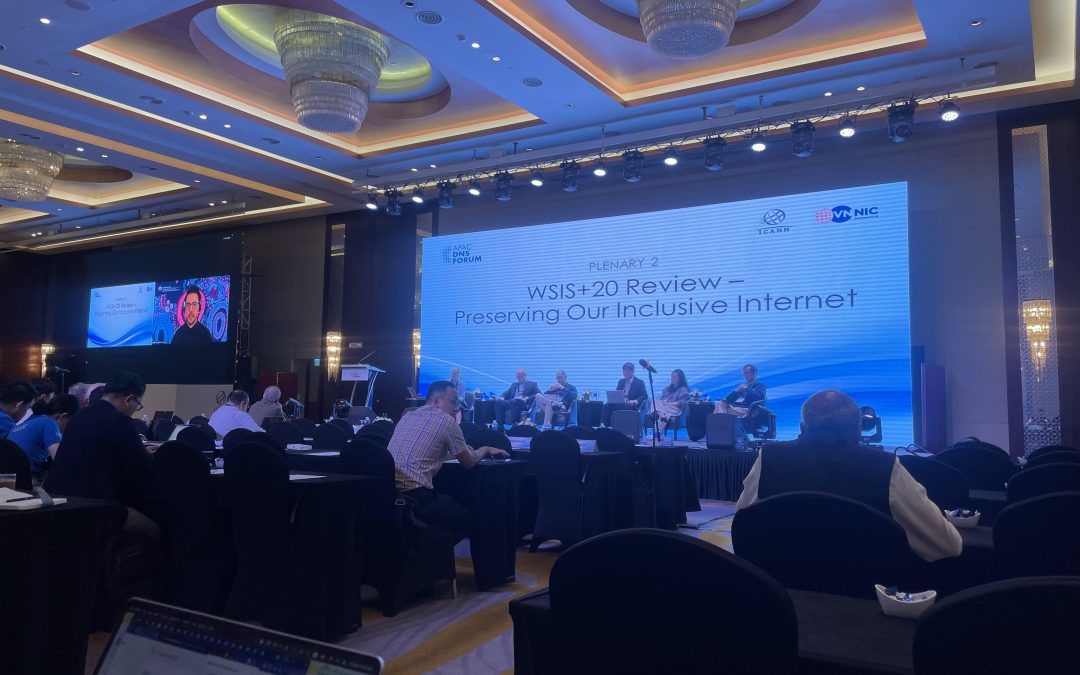
Interactive breakouts and discussions among participants during GoCreate! Domain Innovations: New Ways of Using Domains, 8 May 2025.

L-R: Fred Hsu, CEO of D3, Le Hai Binh, President of MatBao, Jennifer Chung, VP of Policy for DotAsia, Pham Thu Ngan from NetMission, Edmon Chung, CEO of DotAsia, and Henry Tye, CEO of BigDomain Malaysia, facilitated the brainstorm for GoCreate! Domain Innovations.
“The Southeast Asian region has a really, really big group of digital natives, and they’re very technology savvy,” says NetMission Ambassador Pham Thu Ngan.
The Association of Southeast Asian Nations (ASEAN) reports that over one-third of its population, which will reach 700 million by 2030, is comprised of youth. Market research also indicates that this group is becoming a leading force in the global ecommerce market, engaging in activities such as online shopping, ride-sharing and AI travel planning. With rapidly developing market power and technically savvy youth, Ngan hones in on the “million-dollar question”: “Why don’t they have a digital home yet? Many of them don’t, because while youth are curious, they are also very pragmatic.”
This means youth are not only considering price, but the cost-performance value of domains.
“The Southeast Asian region has a really, really big group of digital natives, and they’re very technology savvy…Youth are also hustlers, they have their own business ecommerce, they’re entrepreneurs and they need somewhere to show that their business is trustworthy.”
Pham Thu Ngan, NetMission Ambassador
Domain Usage Drivers for Youth
Ngan presented research findings on youth behavior regarding domains during the GoCreate! New Ways of Using Domain Names session at the ICANN APAC DNS Forum 2025 in Hanoi. She identified four main categories of youth domain usage trends: personal profiles, personal branding, social and community projects, and investment as digital assets. Ngan emphasized that young people frequently manage multiple social media profiles but lack a reliable central online presence. She also stated that “youth are also hustlers, they have their own business ecommerce, they’re entrepreneurs and they need somewhere to show that their business is trustworthy.”
Other panelists agreed. Fred Hsu, CEO of D3, Le Hai Binh (“Benson”), President of MatBao, Edmon Chung, CEO of DotAsia, and Henry Tye, CEO of BigDomain, with over a century of DNS market experience between them, all shared stories of domain names being used for the consolidation of personal digital identity.
The GoCreate! series initiated by DotAsia is envisioned to be a dynamic series of gatherings exploring the expansion of the DNS marketplace. Jennifer Chung, VP of Policy at DotAsia explained at the inaugural GoCreate! session that, “We’re exploring new technologies and how we use domain names in different ways. We want to engage all of the different perspectives, from industry insiders to the youth and people with fresh ideas to see how we can drive the expansion of the global DNS and stimulate innovation of the domain market space.”
It appears that Hanoi, with its strong and sweet Vietnamese coffee, provided the secret ingredient for sparking this brainstorming session on the future of domain names.
Cracking Open the Personal Digital Identity Market
Benson from MatBao shared an interesting story about a conversation he had with a friend who questioned the future of the domain name market. Shortly into the conversation, Benson discovered his friend “had many social media profiles, two phone numbers and he gathered all his stuff and his company’s fan pages, ecommerce shop and other information onto his small business card. So I told him, MatBao just launched Canvato (an e-business-card service), which provides a link to your profile with your achievements, your photo, your video; everything in one page, with your own name on a web address.”
Benson’s friend guaranteed he would use the personal profile “because he really wants to gather all the information into one place, and I told him that if you want it to be more professional you should buy a domain name and use that.” By the end of the conversation, Benson’s friend was convinced that “this new idea can sell millions of domains in Vietnam.”
Building on the widespread dependence on social media platforms, Henry at BigDomain emphasized that transitioning business activities to their own domains is not primarily about the cost, but rather the complexity of setting up and maintaining fresh content on their website: “People are more interested to go to our social media to get updated product information, but not our website because we’re putting boring stuff on our website and a big chunk of it is outdated. Domain names are just a small cost of digital branding, and for any dollar they spend on marketing their website, companies are spending 10 times the cost in creating their social media content. We should look at what content would entice our users, and make them come to our website more often than our social media. I think that is the key.”
Edmon and Ngan agreed and emphasized that simplified interfaces that allow for easy updating and broadcasting of content, or even gamified experiences for youth to configure DNS, email addresses and social handles, can be instrumental in bringing new users and businesses onto their own domains. Edmon added that URL shorteners present creative and readily available functionalities for brands to utilize additional TLDs. “We’re seeing, for example, brands like Channel News Asia continue to use their ‘.com’ domain for their corporate site, but utilize ‘cna.asia’ for each of their published news articles, with the headline in the URL for SEO purposes.”
Web3, Domain Tokenization and the Fediverse
The conversation shifted to the dimension of Web3, where Fred at D3 underscored the importance of usability when it comes to domain names. He stated, “We want to bring accessibility, security and transparency to this asset class.” Reflecting on the phenomenon of crypto and Web3 naming systems, Fred pointed out that, “Web3 extensions were kind of like an interesting but ultimately failed experiment. The reason why they took off and kind of quickly puttered out is because they’re incompatible. They’re illiquid. It’s a fragmented ecosystem. They’re ultimately alt assets.”
“What they call Web3 extensions were kind of like an interesting but ultimately failed experiment…they’re incompatible. They’re illiquid. It’s a fragmented ecosystem. They’re ultimately alt assets…but a unified approach could grow the domain market from millions to trillions.”
Fred Hsu, CEO, D3
Fred proposed tokenizing domain names to unlock their value. “This market has a lot of upside to grow, we just have to tokenize this asset, much like people are talking about tokenizing real estate, tokenizing treasuries, and tokenizing gold. So we think it’s an ambitious but realistic goal.”
A recent report by Deloitte predicts that USD 4 trillion of real estate will be tokenized by 2035, a substantial increase from less than USD 0.3 trillion in 2024, with a CAGR of 27%. Other reports also share an optimistic outlook on the tokenization trend. The World Economic Forum suggests that up to 10% of global GDP could be tokenized and stored on the blockchain by 2027. Additionally, a 2022 report from the Boston Consulting Group (BCG) and ADDX estimates that asset tokenization for various financial and real world assets, such as equity, bonds, funds, art, real estate, commodities, and patents will reach USD 16 trillion by 2030.
Fred is equally bullish on domain tokenization. He boldly projected, “We want to build this whole ecosystem together and expand way beyond 360 million domain names today. Today’s Web3 domains are fragmented and incompatible, but a unified approach could grow the domain market from millions to trillions.”
The promise of remarkable growth in the tokenization market is based on unlocking the illiquidity of assets, as Fred pointed out—which aligns with the growing interest of youth in domain investment identified by Ngan.
Edmon added that “Web3 is not just about blockchain, but also about the decentralized social web, which is called the Fediverse. The Fediverse means people can use their own personal or corporate domains as their social media platform, while allowing users from any platform to follow them, and interact.” This approach liberates people from being confined to a single platform, like Facebook, X or LinkedIn, using domain names as their profile handles.
According to the BBC, there is a significant exodus from predatory social media platforms, with a nearly 25% decrease in daily active users on X since January 2025, and only about a third of teens now using Facebook or X compared to 75% a decade ago. Initiatives like Free Our Feeds and the AT Protocol pioneered by Bluesky support personal digital sovereignty and data portability, by promoting universal user handles through domain names. By introducing complementary incentives and user-friendly interfaces, young and savvy users may soon be able to build their own digital homes with their own domain names.
Brainstorming Innovation
Fueled by local caffeine, participants at GoCreate! explored stimulating challenges in breakout groups and uncovered a plethora of insights and innovations. Alban Kwan, Regional Director of East Asia for CSC, summarized the breakout sessions and observed that two consistent themes had emerged from the many creative ideas. He jokingly remarked, “The other group seems to have spied on us and stolen our ideas!”
The first theme involved personalized digital identifiers replacing outdated technologies— while the second focused on the adoption of DNS for device identity management, particularly in the Internet of Things (IoT) or Drone Remote ID Protocol (DRIP).
Alban closed the session with the observation that “the online world and the offline world are merging,” echoing the interventions from other panelists and participants. He agreed with Ngan’s insight into youth domain usage, and her statement that social media “is a gateway that introduces youth to the meaningful use of domain names.”
Edmon called the DNS industry players to take action: “Let’s push people back on domains.”
He concluded the importance of the DNS serves as a “trust anchor” and foundation for the rapidly evolving Internet landscape. “New uses will probably evolve around digital identity, authentication and credentialing. Personal domain names, like a personalized unique identifier, can include e-namecards, business cards, and even birth certificates. The consolidation of online identities can all be achieved with a domain name.”
“This is just the start, not the end,” stated Jennifer, wrapping up the inaugural session of the GoCreate! series.
GoCreate! aims to stimulate innovation in the domain market space, by exploring new technologies and usage of domain names to drive the expansion of the global DNS. The GoCreate! collaborative series will engage perspectives from different stakeholders, serving as a knowledge-sharing, thought-leadership and collective brainstorming platform to foster a deeper understanding and increased adoption of domain name assets within the digital landscape.
If you are interested in collaborating with DotAsia and sharing your ideas for the GoCreate! series, please do not hesitate to contact us at info[at]dot.asia.
